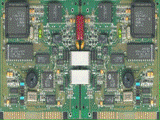Electrical and Computer Engineering, Department of

Department of Electrical and Computer Engineering: Faculty Publications (to 2015)
Document Type
Article
Date of this Version
2008
Abstract
Performance evaluations of multi-hop ad hoc network routing protocols have been primarily conducted through analytic and simulation-based studies, which frequently fail to accurately predict real-world performance and behaviour. One reason for this is the challenge in developing low cost, representative test beds with the degree of flexibility and mobility required. We have developed a Portable Wireless Ad hoc Node (PWAN) device which establishes multi-hop routes using the OLSR routing protocol. The PWAN’s performance has been investigated using two test bed configurations to evaluate its capacity under conditions of high node density in a short-range, multi-hop environment. Our results illustrate that such networks are capable of providing high quality connections when traffic density is low. However, the network link quality deteriorates dramatically as the traffic level increases, and the network topology becomes unstable until the traffic level is reduced.


Comments
Published in Signal Processing and Communication Systems, 2008. ICSPCS 2008. 2nd International Conference on 15-17 Dec. 2008 Page(s):1 - 6. ©2008 IEEE.